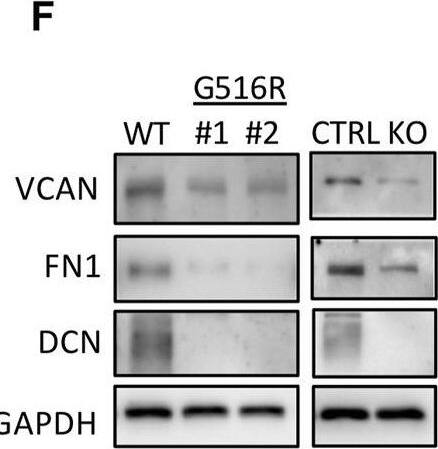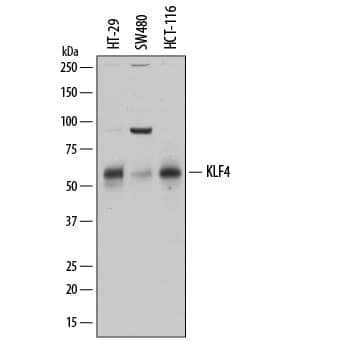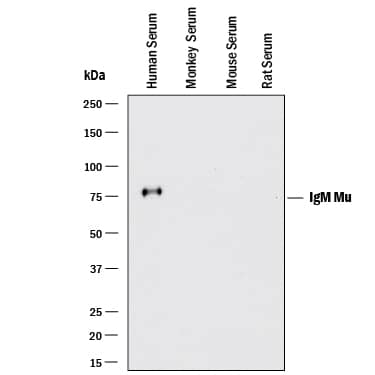Human Decorin Antibody Summary
Gly17-Lys172
Accession # NP_598013.1
Customers also Viewed
Applications
Please Note: Optimal dilutions should be determined by each laboratory for each application. General Protocols are available in the Technical Information section on our website.
Scientific Data
 View Larger
View Larger
Detection of Human Decorin by Western Blot. Western blot shows lysates of human uterus tissue and human heart tissue. PVDF membrane was probed with 1 µg/mL of Mouse Anti-Human Decorin Monoclonal Antibody (Catalog # MAB143) followed by HRP-conjugated Anti-Mouse IgG Secondary Antibody (Catalog # HAF018). A specific band was detected for Decorin at approximately 100 kDa (as indicated). This experiment was conducted under reducing conditions and using Immunoblot Buffer Group 1.
 View Larger
View Larger
Detection of Human Decorin by Simple WesternTM. Simple Western lane view shows lysates of human uterus tissue, loaded at 0.2 mg/mL. A specific band was detected for Decorin at approximately 145 kDa (as indicated) using 10 µg/mL of Mouse Anti-Human Decorin Monoclonal Antibody (Catalog # MAB143). This experiment was conducted under reducing conditions and using the 12-230 kDa separation system.
 View Larger
View Larger
Detection of Human Decorin by Immunohistochemistry Immunohistochemical staining of stromal protein expression in DCIS with sclerotic or myxoid stromaMicrophotographs displaying HE staining (A-B), and IHC staining for biglycan (C-D), decorin (E-F) and versican (G-H). Panels A-C-E-G display photographs of one DCIS lesion with sclerotic stroma; panels B-D-F-H display one DCIS lesion with myxoid stroma. This figure illustrates that myxoid DCIS present reduced periductal decorin staining and tend to have increased periductal versican and biglycan expression, whereas sclerotic DCIS generally present strong stromal decorin immunoreactivity, and tend to lack stromal versican and biglycan. Original magnification 100x. Image collected and cropped by CiteAb from the following publication (https://www.oncoscience.us/lookup/doi/10.18632/oncoscience.87), licensed under a CC-BY license. Not internally tested by R&D Systems.
 View Larger
View Larger
Detection of Human Decorin by Western Blot Treatment of CAFs with combined cytokines or cancer cell-derived secretomes affects ECM protein expression(A) Western blot showing the effects of bFGF, EGF and TGF-beta 1 treatment (10 ng/ml) on the expression of biglycan, decorin, alpha -SMA and versican in CAFs. (B) Western blot illustrating the effects of treatment with cancer cell-derived conditioned medium (CM) on the expression of biglycan, decorin, alpha -SMA and versican in CAFs. TGF-beta 1 treatment (1 and 10 ng/ml) was included as a positive control. Tubulin was used as loading control (A, B). Image collected and cropped by CiteAb from the following publication (https://www.oncoscience.us/lookup/doi/10.18632/oncoscience.87), licensed under a CC-BY license. Not internally tested by R&D Systems.
 View Larger
View Larger
Detection of Human Decorin by Immunohistochemistry Immunohistochemical staining of stromal protein expression in DCIS with sclerotic or myxoid stromaMicrophotographs displaying HE staining (A-B), and IHC staining for biglycan (C-D), decorin (E-F) and versican (G-H). Panels A-C-E-G display photographs of one DCIS lesion with sclerotic stroma; panels B-D-F-H display one DCIS lesion with myxoid stroma. This figure illustrates that myxoid DCIS present reduced periductal decorin staining and tend to have increased periductal versican and biglycan expression, whereas sclerotic DCIS generally present strong stromal decorin immunoreactivity, and tend to lack stromal versican and biglycan. Original magnification 100x. Image collected and cropped by CiteAb from the following publication (https://www.oncoscience.us/lookup/doi/10.18632/oncoscience.87), licensed under a CC-BY license. Not internally tested by R&D Systems.
 View Larger
View Larger
Detection of Human Decorin by Western Blot Treatment of CAFs with combined cytokines or cancer cell-derived secretomes affects ECM protein expression(A) Western blot showing the effects of bFGF, EGF and TGF-beta 1 treatment (10 ng/ml) on the expression of biglycan, decorin, alpha -SMA and versican in CAFs. (B) Western blot illustrating the effects of treatment with cancer cell-derived conditioned medium (CM) on the expression of biglycan, decorin, alpha -SMA and versican in CAFs. TGF-beta 1 treatment (1 and 10 ng/ml) was included as a positive control. Tubulin was used as loading control (A, B). Image collected and cropped by CiteAb from the following publication (https://www.oncoscience.us/lookup/doi/10.18632/oncoscience.87), licensed under a CC-BY license. Not internally tested by R&D Systems.
 View Larger
View Larger
Detection of Human Decorin by Western Blot Secretome analysis of WT, COG4p.G516R, and COG4-KO chondrosarcoma cells. (A) Coomassie blue staining of proteins in cell lysates and conditioned medium from COG4p.G516R clones #1, #2, WT controls and COG4 KO cells. (B) Volcano plot of differentially secreted proteins between COG4p.G516R and WT. (C) Volcano plot of differentially secreted proteins between COG4p.G516R and COG4-KO cells. A few top candidates confirmed by pathway analysis were labeled respectively. (D) Dot plot showing enriched pathways from Gene Set Enrichment Analysis with the Normalized Enrichment Score (NES) shown on the X-axis. The size of the dots represents the number of genes in the significant Data Set list associated with the GO term and the color of the dots represent the adjusted p- values. (E) Table showing a list of top 10 candidates which were decreased in secretions of COG4p.G516R with log 2 (Fold Change) and adjusted p-value shown for COG4p.G516R vs. WT and COG4p.G516R vs. COG4-KO. The number of peptides is equal to or more than two for all the candidates shown in table. (F) Western blotting of top candidates in medium decreased in both COG4p.G516R and COG4-KO cells compared to WT. GAPDH was from cell lysates with comparable amount as loading control. (G) Western blotting of top candidates only changed in COG4p.G516R compared to WT and COG4-KO cells. All experiments were performed in duplicate with similar results. Image collected and cropped by CiteAb from the following open publication (https://pubmed.ncbi.nlm.nih.gov/36393834), licensed under a CC-BY license. Not internally tested by R&D Systems.
Preparation and Storage
- 12 months from date of receipt, -20 to -70 °C as supplied.
- 1 month, 2 to 8 °C under sterile conditions after reconstitution.
- 6 months, -20 to -70 °C under sterile conditions after reconstitution.
Background: Decorin
Decorin is a small secreted chondroitin/dermatan sulfate proteoglycan in the family of small leucine-rich proteoglycans (SLRPs). SLRP family members are characterized by N-terminal and C-terminal cysteine-rich regions which flank the central region containing 10-12 tandem leucine-rich repeats (LRR) (1, 2). The human Decorin cDNA encodes a 359 amino acid (aa) precursor that includes a 16 aa signal sequence and a 14 aa propeptide. The 329 aa mature protein contains twelve LRR. Alternate splicing generates five isoforms with variable length deletions (3). Mature human and mouse Decorin share 80% aa sequence identity. In Decorin, serine 34 in the N-terminal domain is O-glycosylated. Naturally occurring Decorin proteoglycan has a molecular mass of approximately 100 kDa, and the deglycosylated Decorin core protein has a mass of approximately 40 kDa. Decorin binds to fibronectin, TGF-beta, and type I and type II collagens. The binding of Decorin to various molecules was reported to be mediated via the core protein. Decorin has been implicated in matrix assembly and has also been reported to suppress the growth of various tumor cell lines by activating the epidermal growth factor receptor.
- Naito, Z. (2005) J. Nippon Med. Sch. 72:137.
- Matsushima, N. et al. (2005) Cell. Mol. Life Sci. 62:2771.
- Danielson, K. et al. (1993) Genomics 15:146.
Product Datasheets
Citations for Human Decorin Antibody
R&D Systems personnel manually curate a database that contains references using R&D Systems products. The data collected includes not only links to publications in PubMed, but also provides information about sample types, species, and experimental conditions.
17
Citations: Showing 1 - 10
Filter your results:
Filter by:
-
Loss of ADAM9 Leads to Modifications of the Extracellular Matrix Modulating Tumor Growth
Authors: Anna N. Abety, Elke Pach, Nives Giebeler, Julia E. Fromme, Lavakumar Reddy Aramadhaka, Cornelia Mauch et al.
Biomolecules
-
While Urine and Plasma Decorin Remain Unchanged in Prostate Cancer, Prostatic Tissue Decorin Has a Prognostic Value
Authors: Razie Rezaie, Zeinab Falakian, Saeideh Mazloomzadeh, Mohsen Ayati, Arman Morakabati, Mohammad Reza Teimouri Dastjerdan et al.
Iranian Biomedical Journal
-
Effects of a skin-massaging device on the ex-vivo expression of human dermis proteins and in-vivo facial wrinkles
Authors: Elisa Caberlotto, Laetitia Ruiz, Zane Miller, Mickael Poletti, Lauri Tadlock
PLOS ONE
-
Systemically Administered Homing Peptide Targets Dystrophic Lesions and Delivers Transforming Growth Factor-beta (TGFbeta) Inhibitor to Attenuate Murine Muscular Dystrophy Pathology
Authors: A Iqbal, U May, SN Prince, TAH Järvinen, A Heydemann
Pharmaceutics, 2021-09-18;13(9):.
Species: Human
Sample Types: Recombinant Proteins
Applications: Western Blot -
Loss of ADAM9 Leads to Modifications of the Extracellular Matrix Modulating Tumor Growth
Authors: Anna N. Abety, Elke Pach, Nives Giebeler, Julia E. Fromme, Lavakumar Reddy Aramadhaka, Cornelia Mauch et al.
Biomolecules
-
Regional contribution of proteoglycans to the fracture toughness of the dentin extracellular matrix
Authors: Y Alania, J Creighton, LT Trevelin, CA Zamperini, AK Bedran-Rus
J Biomech, 2020-01-16;0(0):109633.
Species: Human
Sample Types: Complex Sample Type
Applications: IHC -
Conferring extracellular matrix affinity enhances local therapeutic efficacy of anti-TNF-alpha antibody in a murine model of rheumatoid arthritis
Authors: K Katsumata, J Ishihara, K Fukunaga, A Ishihara, E Yuba, E Budina, JA Hubbell
Arthritis Res. Ther., 2019-12-23;21(1):298.
Species: Human
Sample Types: Whole Tissue
Applications: IHC-Fr -
Transcriptome analysis of skin fibroblasts with dominant negative COL3A1 mutations provides molecular insights into the etiopathology of vascular Ehlers-Danlos syndrome
Authors: N Chiarelli, G Carini, N Zoppi, M Ritelli, M Colombi
PLoS ONE, 2018-01-18;13(1):e0191220.
Species: Human
Sample Types: Whole Cells
Applications: ICC -
Dermatan sulfate is a player in the transglutaminase 2 interaction network
Authors: G Wisowski, EM Ko?ma, T Bielecki, A Pude?ko, K Olczyk
PLoS ONE, 2017-02-15;12(2):e0172263.
Species: Human
Sample Types: Cell Culture Supernates
Applications: Immunoprecipitation -
Proteomics of thyroid tumours provides new insights into their molecular composition and changes associated with malignancy
Authors: J Martínez-A, R Clifton-Bl, MP Molloy
Sci Rep, 2016-03-30;6(0):23660.
Species: Human
Sample Types: Tissue Homogenates
Applications: Western Blot -
Defective Proteolytic Processing of Fibrillar Procollagens and Prodecorin Due to Biallelic BMP1 Mutations Results in a Severe, Progressive Form of Osteogenesis Imperfecta.
Authors: Syx D, Guillemyn B, Symoens S, Sousa A, Medeira A, Whiteford M, Hermanns-Le T, Coucke P, De Paepe A, Malfait F
J Bone Miner Res, 2015-05-21;30(8):1445-56.
Species: Human
Sample Types: Cell Culture Supernates
Applications: Western Blot -
Possible dual role of decorin in abdominal aortic aneurysm.
Authors: Ueda, Koshiro, Yoshimura, Koichi, Yamashita, Osamu, Harada, Takasuke, Morikage, Noriyasu, Hamano, Kimikazu
PLoS ONE, 2015-03-17;10(3):e0120689.
Species: Human
Sample Types: Tissue Homogenates, Whole Tissue
Applications: IHC, Western Blot -
Faulty initiation of proteoglycan synthesis causes cardiac and joint defects.
Authors: Baasanjav S, Al-Gazali L, Hashiguchi T, Mizumoto S, Fischer B, Horn D, Seelow D, Ali BR, Aziz SA, Langer R, Saleh AA, Becker C, Nurnberg G, Cantagrel V, Gleeson JG, Gomez D, Michel JB, Stricker S, Lindner TH, Nurnberg P, Sugahara K, Mundlos S, Hoffmann K
Am. J. Hum. Genet., 2011-07-15;89(1):15-27.
Species: Human
Sample Types: Cell Culture Supernates
Applications: Western Blot -
Lack of CXC chemokine receptor 3 signaling leads to hypertrophic and hypercellular scarring.
Authors: Yates CC, Krishna P, Whaley D, Bodnar R, Turner T, Wells A
Am. J. Pathol., 2010-03-04;176(4):1743-55.
Species: Mouse
Sample Types: Whole Tissue
Applications: IHC-P -
Role of decorin in the antimyeloma effects of osteoblasts.
Authors: Li X, Pennisi A, Yaccoby S
Blood, 2008-04-24;112(1):159-68.
Species: Human
Sample Types: Cell Lysates, Whole Cells
Applications: ICC, Western Blot -
TMEM165 a new player in proteoglycan synthesis: loss of TMEM165 impairs elongation of chondroitin- and heparan-sulfate glycosaminoglycan chains of proteoglycans and triggers early chondrocyte differentiation and hypertrophy
Authors: Sajida Khan, Malak Sbeity, François Foulquier, Lydia Barré, Mohamed Ouzzine
Cell Death & Disease
-
The role of extracellular matrix in mouse and human corneal neovascularization
Authors: Barbariga M, Vallone F, Mosca E et al.
Sci Rep
FAQs
No product specific FAQs exist for this product, however you may
View all Antibody FAQsIsotype Controls
Reconstitution Buffers
Secondary Antibodies
Reviews for Human Decorin Antibody
Average Rating: 5 (Based on 1 Review)
Have you used Human Decorin Antibody?
Submit a review and receive an Amazon gift card.
$25/€18/£15/$25CAN/¥75 Yuan/¥2500 Yen for a review with an image
$10/€7/£6/$10 CAD/¥70 Yuan/¥1110 Yen for a review without an image
Filter by:

















